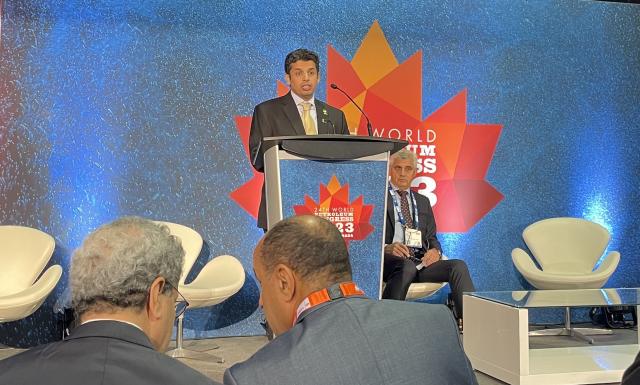
Ghaithan Al-Muntasheri, CEO of Saudi Aramco Upstream Technology Center, at the World Petroleum Congress in Calgary, Alberta, Sept. 18. (Source: Hart Energy)
CALGARY, Alberta—The world will need more energy security, access and affordability as the global population nears 10 billion in the coming decades, experts say. As people attempt to solve these issues, the world’s biggest energy player, Saudi Aramco, plans to be at the forefront of innovation during the energy transition.
At the World Petroleum Congress Sept. 18, Ghaithan Al-Muntasheri, CEO of Saudi Aramco Upstream Technology Center, said Aramco is investing in numerous methods aimed at lowering emissions associated with producing oil and gas.
“When it comes to innovation, a giant challenge will always require a giant new technology,” said Al-Muntasheri. “Carbon capture and storage and lowering the upstream methane intensity are two examples of technologies that will enable us to reach our goal.”
Aramco recently announced a $1.5 billion sustainability fund to finance research exploring technologies that could lower its upstream carbon intensity—currently at 10.3 kg CO₂e/boe. Saudi Arabia aims to capture and store 44 mtpa of CO₂ by 2035.
“With this fund, we are stepping up to address the challenges in pursuit of lower carbon emissions and energy intensity. This fund is meant to increase the initiatives in carbon capture,” Al-Muntasheri said. “It is going to drive the advancements in renewable energy and carbon storage solutions.”
Aramco’s green technology
Currently, the company is developing with Linde and SLB the Jubail CCS Hub to be one of the largest carbon capture and storage (CCS) facilities in the world. Phase one of the hub is intended to capture CO₂ from three Aramco gas plants and other downstream industrial facilities. Operations are set to begin in 2027, capturing and storing up to 9 million tonnes per annum (mtpa) of CO₂.
Aramco is also progressing its nanotechnology capabilities in its quest for carbon sequestration. The goal is to help Aramco extract oil more sustainably for the long term, Al-Muntasheri said.
When CO₂ is captured in liquid form, CO₂ bubbles are formed. So-called nanobubbles have the ability to sequester more CO₂ in the same reservoir than common, larger-sized CO₂ bubbles. For unconventional formations, Aramco is exploring nanobubble CCS technology to chemically treat formations to increase sequestration capacity.
CO₂ nanobubbles are also being considered for green energy applications, such as algae bio-crude production, he said. The algae also consumes CO₂ faster than other methods of carbon capture.
To manage produced water, Aramco is developing a zero-liquid discharge technology that relies on flow dynamics. The cyclone configuration used restores hypersaline-produced water to almost drinking quality. Aramco also uses the precipitation method to remove sulfate from seawater.
“The water resources are scarce and the utilization of this technology is going to help us move some of these produced waters to others. It's also an enabler for us to use that water in other applications from upstream operations.” Al-Muntasheri said.
The final frontier for Aramco may be quantum computing, he said. Quantum computing can address a wide range of upstream, midstream and downstream challenges, including network optimization, reaction network generation and refinery linear programming.
“Quantum computing will bring us massive and faster processing for our data that will help us in exploration,” Al-Muntasheri said. “We will be able to generate subsurface images at a much better quality and, therefore, reduce the uncertainty when we drill.
“We will be able to optimize the drilling operations by looking at all the parameters of the reservoir and, when it comes to reservoir simulation, we will be able to generate extensive models that will help us make the decisions.”
Recommended Reading
Not Sweating DeepSeek: Exxon, Chevron Plow Ahead on Data Center Power
2025-02-02 - The launch of the energy-efficient DeepSeek chatbot roiled tech and power markets in late January. But supermajors Exxon Mobil and Chevron continue to field intense demand for data-center power supply, driven by AI technology customers.
Ovintiv Names Terri King as Independent Board Member
2025-01-28 - Ovintiv Inc. has named former ConocoPhillips Chief Commercial Officer Terri King as a new independent member of its board of directors effective Jan. 31.
Phillips 66’s NGL Focus, Midstream Acquisitions Pay Off in 2024
2025-02-04 - Phillips 66 reported record volumes for 2024 as it advances a wellhead-to-market strategy within its midstream business.
More Players, More Dry Powder—So Where are the Deals?
2025-03-24 - Bankers are back and ready to invest in the oil and gas space, but assets for sale remain few and far between, lenders say.
Murphy Shares Drop on 4Q Miss, but ’25 Plans Show Promise
2025-02-02 - Murphy Oil’s fourth-quarter 2024 output missed analysts’ expectations, but analysts see upside with a robust Eagle Ford Shale drilling program and the international E&P’s discovery offshore Vietnam.
Comments
Add new comment
This conversation is moderated according to Hart Energy community rules. Please read the rules before joining the discussion. If you’re experiencing any technical problems, please contact our customer care team.





